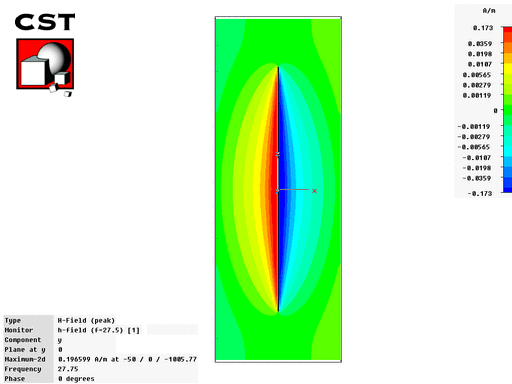CDX-007, I can't help you to accept the idea that more then one radial is active in any one direction. It is a fact take it or leave it. I've experimented with this antenna enough to know that both the shielding effect and radiation effect of the cone benefited from having the 4th radial added to the design. From your point of view as long as one radial was facing the desired direction no gain would be seen adding the 4th. This is simply not true.
Using a field strength meter at various points along the antenna would show nothing even remotely similar to the CST image. The field strength meter does not react to the maximum current point on the antenna. It responds to increases in RF voltage and shows the highest reading where the highest voltage is. Hold one up to your 102 inch whip if you don't believe me. The highest reading will be at the tip which just happens to be where the least radiation current is.
I don't question that the TOA will suffer from being mounted too low to the ground or that close proximity to other antennas would effect the pattern. I will say it shows no significant change in VSWR where many other antennas do. My point here is my roof and mast are tall enough to remove this variable.
Marconi, I'm not sure what you mean by me pausing. I only tested the GM on the ground first to confirm the antenna had a reasonable match, bandwidth, and could handle my TX power before going through the trouble to install it. I did this because I needed coverage of 10 and 11 meters. In all honestly I did not test signals on the ground but the VSWR did not change.
Unless it was raining, snowing, or your roof is metal, the roof itself really cannot effect the antenna. Asphalt shingles and plywood simply do not effect RF at HF frequencies. In the absence of those conditions during your tests, it was the height above ground that made the difference, not height above the roof. Being that it does snow, rain, and some roofs have metal in them are probably the reasons Sirio recommends 6 feet or more clearance.
No, I believe you misunderstood.
Shockwave, I agree with you that 4 cone radials is better than 3, and I'd expect that adding 20 more cone radials would certainly benefit the cone action (which you have described is performing as both a shield and a radiator) to an even higher degree than adding only 1 more, though there will certainly be a point of diminishing returns.
My point was actually regarding what we are clearly seeing in the "Full-bloom"(?) CST image of the Vector, Below.
- That being what I believe is supposed to be an accurate representative slice at any given point along the circumference of the antenna as it radiates, which shows a relatively much lower level of energy emanating from the bottom ~33% cone in comparison to that of the top ~66%, along with the heart shaped bloom around it which also seems to depict less energy by far radiating from the cone, offering me the idea that the ¼λ cone is radiating much less RF than is the top ½λ.
I would expect a ¼λ 'element' fed, or even just acting, in a collinear fashion, above or below a ½λ element would need to show an equivalent amount of peak RF radiation field, for it to be as efficient a radiating surface as that of it's adjoining ½λ 'element' before it would add the claimed ~1.5-2dB gain it is allegedly adding in the Vector.
Here it looks like only a slight coloring of the RF exited area outside the cone where the area outside the top ½λ is showing a much stronger (not just longer) RF field:

...which is what led me to believe that perhaps if we were to see the entire 360° CST Vector model it might show this is perhaps NOT the full-bloom point in the cycle, and possibly more highly energized when the cone area is not in phase, especially when noticing the red/blue colored RF energized field area around the top ½λ is considerably less pronounced than is the area around the CST model image of the SGM at full bloom, even though more power (A/m) is evidently being applied to the Vector in it's model.
When considering the fullness of the area of color around the SGM compared to the single slice sent to you of the Vector, it appears to me that it is perhaps not a slice at full bloom, suggesting something else might be happening in the cone area regarding phase when the top ½λ actually is in full bloom.



